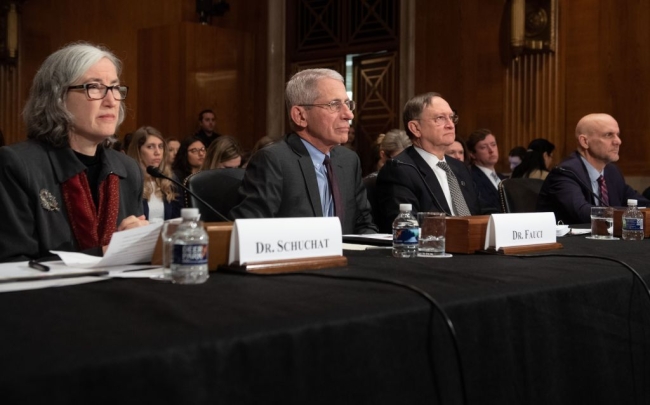You have /5 articles left.
Sign up for a free account or log in.

CDC and NIH officials on Capitol Hill
Getty Images/Saul Loeb
The Centers for Disease Control and Prevention say that colleges should “consider” canceling upcoming student foreign exchange programs and asking current program participants to return to their home countries in light of the global outbreak of a new coronavirus.
The CDC guidance for student travel at institutions of higher education was issued Sunday. Colleges have already canceled many overseas programs in countries with high rates of local transmission of the virus formally called COVID-19, most notably China and Italy. But the CDC guidance is seemingly global in scope, referring to foreign travel by students in general.
Although it is somewhat ambiguous in its wording, the CDC guidance could also be read as referring to both foreign exchange students hosted by U.S. institutions and to Americans studying abroad. The first paragraph says that institutes of higher education, or IHEs, “should consider postponing or canceling upcoming student foreign exchange programs” and “consider asking current program participants to return to their home country.” It notes, "Those overseeing student foreign exchange programs should be aware that students may face unpredictable circumstances, travel restrictions, challenges in returning home or accessing health care while abroad."
The second paragraph says that colleges “should consider asking students participating in study abroad programs to return to the United States.” It advises colleges to "work with state and local public health officials to determine the best approach for when and how (e.g., chartered transportation for countries or areas assessed as high-risk for exposure) their study abroad students might return."
The CDC did not respond to requests for comment about the guidance.
“It’s a major change in policy, and it will be taken very seriously by our members,” Brad Farnsworth, vice president for global engagement at the American Council on Education, said of the CDC guidance.
“They will also take to heart that it’s only a consideration, and I think there will be institutions that decide to leave their programs in place. I think they will look at that very carefully. There is not just a safety issue but also a legal issue: the last thing a university wants is to appear to have been irresponsible by ignoring a statement from the CDC. But I think we will see some exceptions where universities say they’re looking at the situation very closely and they decided that leaving students in place is the best course of action. Institutions already have protocols in place for assessing risk," Farnsworth said.
David DiMaria, the associate vice provost for international education at the University of Maryland, Baltimore County, said the CDC guidance took the field of international education by surprise.
"I’ve gotten text messages and emails from colleagues across the nation trying to make sense of this," DiMaria said. "While it’s certainly helpful to have guidance, there are a lot of questions that remain pertaining to the guidance. For instance, when it says postponing or canceling upcoming foreign student exchange programs, 'upcoming' -- is that spring break, is that summer, is it fall?" DiMaria also noted a lack of clarity around some of the terminology -- for example, what the CDC means by "exchange program."
“Certainly any time the CDC issues guidance, I think all of higher education is going to look to that as an official source, but if we had, I think, a little more specificity, it would certainly help international educators as they make some of these major decisions that have broad implications," DiMaria said.
The Forum on Education Abroad and Pulse, an organization of professionals focused on health and safety in academic travel, issued a joint statement in which they noted that never before has the CDC issued guidance like this in relation to student travel. "Both The Forum and Pulse strongly urge colleagues to read this statement as it is written -- as guidance to consider. It is not a directive that is being handed down," their statement says.
"Students are not typically members of the population who may succumb to a virus like COVID-19. Those populations have often included the elderly and those with compromised immune systems," the groups said. "Unlike typical travelers, students are supported on the ground at their various study sites by professional staff, faculty, and others who work to assure that students are provided information, assistance, guidance, and help when necessary."
"We also want to acknowledge that different institutions will have different capacities to manage a complex issue such as COVID-19. Not every organization can be expected to react in the same way as those with professional staff devoted to addressing international health and safety considerations. We urge those institutions to reach out to your colleagues through professional networks. Look to what they are saying and recommending and then scale it so that it fits your context."
To date, colleges have adjusted their international programming country by country in response to the virus’s spread. But the CDC advisory stresses the dynamic and global nature of the situation.
“Given the speed of spread and the number of countries experiencing human-to-human transmission, IHEs should evaluate the risks associated with choosing to maintain programs abroad and take the appropriate proactive measures,” the guidance states.
On Monday the Texas A&M University system issued new, broader restrictions on foreign student travel. The university said it would "strongly discourage all foreign travel by Texas A&M System students, faculty and staff while the outbreak of COVID-19 remains a dynamically changing and uncertain situation." It said it would "prohibit payment for System-sponsored travel to all countries identified as Level 1 or greater risk by the CDC Health Notice Warning system," and it "encourage[s] all students, faculty and staff to return from all Level 1 or higher risk countries as soon as can be practically arranged."
Sara Schwartz, founder and president of the Massachusetts-based law firm Schwartz Hannum, said the main thing the CDC advisory changes is the institutional risk management calculus.
“My takeaway from the CDC guidance is that every educational institution, whether it is an independent school or a higher ed entity, needs to take seriously the mandate to ‘consider,’” said Schwartz, whose firm represents more than 250 educational institutions. “I think prior to this guidance, we had a lot of flexibility from a risk-management perspective, but the guidance increases the institutional risk of proceeding with these programs. The CDC is saying you better think twice.”
"I’m telling all my schools that this is day to day," said Schwartz. "If they want to keep going on their trips, they can. There's an increased risk from a liability perspective, but they can keep going. They have a green light as long as it’s a level 1 country. But it's riskier. But it’s day to day."
Christine Helwick, a lawyer with the California-based firm Hirschfeld Kraemer and a former general counsel for the California State University system, said she thinks the word “consider” in the CDC message is really important.
“I read the tenor of the message to be, ‘go slow and be thoughtful,’” she said. “That seems to be entirely appropriate because there are so many unknowns about the virus.”
“There are just so many variables that I appreciated the fact that the CDC was not issuing draconian orders,” Helwick added. “It was more, just, you need to think about what your circumstances are, what your risks are. It does seem to me they are encouraging not sending any new students abroad, and that makes sense, but in terms of bringing home students, I read that word 'consider' to give institutions a lot of flexibility but really remind them that they need to be thoughtful. That seems to me about all we can expect of the CDC at this point, and all any of us can do.”




